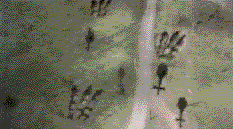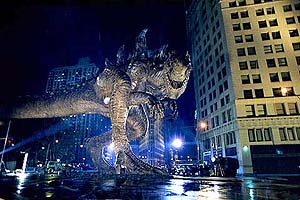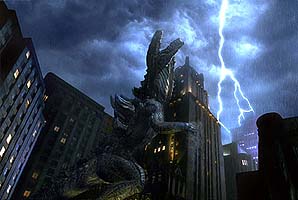
Directed by Roland Emmerich
Visual Effects Supervisor: Volker Engel
Associate Visual Effects Supervisor: Karen Goulekas
Visual Effects Producer: Terry Clotiaux
Digital Effects Producer: Fiona Bull
Visual Effects Art Director: Steve Legler

Directed by Roland Emmerich
Visual Effects Supervisor: Volker Engel
Associate Visual Effects Supervisor: Karen Goulekas
Visual Effects Producer: Terry Clotiaux
Digital Effects Producer: Fiona Bull
Visual Effects Art Director: Steve Legler
Visual Effects Produced by:
VISIONART DESIGN & ANIMATION
SONY PICTURES IMAGEWORKS
DIGISCOPE
Miniatures Created by
Read the Spotlight article: Patrick Tatopoulis: The Man Behind The Monster
Review by Todd Vaziri
The visual effects industry has been excessively maligned as of late. Pundits blame the skyrocketing budgets of Hollywood blockbusters on the film's visual effects. The fact is, for the most part, visual effects teams are doing their jobs: providing films with fantastic visual effects. When a film fails at the box office, it is usually because the film, as a whole, sucked. TITANIC was a blockbuster because it was a good film--and had terrific effects. STARSHIP TROOPERS bombed because it was an awful film--that had terrific effects.
Roland Emmerich's GODZILLA, although it has easily earned over $100 million in the U.S. alone, is a relative box office bomb for one, simple reason: GODZILLA is an horrible, horrible movie. For the most part, the visual effects are not at all to blame. The effects, while not groundbreaking like TITANIC or TROOPERS, are dynamic
Spearheading the visual effects duties of GODZILLA is Emmerich's company, Centropolis Effects, which produced the vast majority of the computer generated imagery for the film, creating the giant monster as well as the beast's baby hatchlings. Sharing in the CG creature duties were VisionArt and Sony Imageworks, while the extensive miniatures were created by Cinnabar, Hunter-Gratzner Industries, and Sightline Productions. Some inserts of the giant creature were accomplished with animatronic versions, and the baby Godzilla's were heavily dependent on animatronic creations, supervised by Patrick Tatopoulos. All in all, GODZILLA's visual effects workload (supervised by Academy Award winner Volker Engel) included some 235 Godzilla CGI shots, part of the 400 visual effects shots for the film.
Much has been said and written about the incessant rain that obscures the giant creature in its New York setting. While the addition of rain to these night shots obscures some artifacts and allows artists to 'get away' with more, it also complicates the CG process, since the creature must appear to be rain-soaked in nearly every scene. Looking at the entire film, the most satisfying Godzilla shots are those where he is completely visible, in daylight, with the camera not moving. Godzilla's first appearance in a New York's harbor featured plenty of daylight (albiet overcast) shots of the giant monster--beginning with tight shots of his massive foot smashing cars, and ending with his dazzling confrontation with cameraman Hank Azaria, where Godzilla is fully revealed. Early shots of the sequence contained terrific matchmoving--the real camera and the CG camera were perfectly in synch--and the interaction between the CG creature and the real-life elements, like cars and people, was very convincing. Careful attention to shadows and extensive rotoscoping of foreground elements allowed these sequences to be successful, although the lack of motion blur on the creature frequently hurt CG shots.
CENTROPOLIS EFFECTS
Executive Producer: Marc Kolbe
Producer: Craig Mumma
CG Supervisors: Steffen Wild, Carolin Quis
Compositing Supervisors: Mitch Drain, Conny Fauser-Ruemelin
President: Steven Puri
Supervisor: Joshua Rose
SIGHTLINE PRODUCTIONS
Director of Photography: Anna Foerster
Miniature Effects Supervisor: Don Baker
Supervisor: Jerome Chen
CINNABAR
HUNTER-GRATZNER INDUSTRIES
tvaziri@gmail.com
 and exciting. It is the film that audiences and critics are rejecting--GODZILLA completely lacks quality in its direction, screenplay and performances, and has none of the humor or character of Emmerich's INDEPENDENCE DAY.
and exciting. It is the film that audiences and critics are rejecting--GODZILLA completely lacks quality in its direction, screenplay and performances, and has none of the humor or character of Emmerich's INDEPENDENCE DAY.
 The mutated lizard wanders its way through New York City. The CGI Godzilla was created by newly formed Centropolis Effects. Only a handful of shots of the title creature were completed with animatronic versions of the beast.  ©1998 Tri-Star Pictures |
The subsequent full-body shots of Godzilla confronting Azaria are brilliant, especially because of the kinetic camera movement. The director was able to use as many dollys and cranes as he wanted, and the CG and compositing teams were able to place the creature realistically within the scene. The best shot of the sequence is a terrific rotational camera move around Azaria as Godzilla approaches his position. Once again, lighting and rotoscoping of these shots make them successful.
Less successful is the design and texture of Godzilla. A monster movie's main creature needs to have character--something inherent to the design of the beast that lends an idea as to its character, its emotions, its desires. TROOPERS' bugs, JURASSIC PARK's dinosaurs, even T2's T-1000 all have some visual characteristics that give us a glimpse of what drives them. Godzilla looks like a man in a lizard suit, plainly and simply. This is not only due to the design, but the choreography and direction of the Godzilla sequences. There seems to be no rhyme or reason to his movements; the audience subsequently cares very little about this creature.
Not to be forgotten are some of the film's non-lizard effects shots. The very best of which is the fantastic helicopter shot of the beached tanker found on the Panamanian coast. From the POV of a hovering helicopter, the camera rotates around the massive liner, perched on the sandy shores of the beach. The shot is incredible--the CG boat is perfectly lit and matchmoved into the scene, even with the
|
"...the compositing of the creature into the backgrounds make these effects shots look like... well... effects shots." |
Speaking of helicopters, they're all over GODZILLA. Flying overhead, helicopter POVs, even in the distant background, there are dozens upon dozens of shots involving the compositing of CG and model helicopters into background plates. The most convincing shots are those where the camera is on the ground, slightly drifting to follow the path of the choppers. The most obvious are those where the helicopters fly only a few feet away from the camera, in situations where no real camera could possibly photograph the action. Overall, textures and lighting of the helicopters are quite realistic.
As these choppers pursue Godzilla through the streets of New York, the camera weaves down city streets. The CG creature and (mainly) CG helicopters were composited into background plates of miniature cityscapes, and although these shots are exciting, they do not look photorealistic. The lights from buildings' windows are far too bright and have an unnatural glow, and the compositing of the creature into the backgrounds make these effects shots look like... well... effects shots. The miniatures for the film, overall, are quite fantastic--the best of which appear in daylight shots, where miniature buildings are destroyed right and left with the accurate appearance of scale.
As revealed by a massive panning shot of the Madison Square Garden interior, Godzilla has laid hundreds of eggs. The reveal shot, realized with extensive miniatures, looks muddy and blurry, while subsequent shots of the Garden interior are much more successful. (An earlier version of this review incorrectly stated that a matte painting was used for the reveal shot. VFX HQ regrets the error.) The hatchlings were executed with a combination of animatronic and CG techniques, and the visual differences between them is obvious. Many of the CG baby shots seemed rushed--lighting, animation and compositing are sometimes brilliant,
|
"It's too bad that director Emmerich and producer Dean Devlin couldn't have done a better job creating the non-effects shots." |
The single best Godzilla sequence occurs after his 'resurrection'--his chase of our heroes, fleeing in a NYC cab, as Godzilla pursues them. Although one must suspend disbelief heavily for the sequence to work (as if big 'G' couldn't smash the cab with one swoop of his foot), the scene displays the best animation, lighting, and compositing of any other of the film. The Brooklyn Bridge sequence is perhaps more complicated than it has to be, with the bridge disintegrating around Godzilla, poles and supports flying all over the place. The eventual destruction of the beast isn't particularly interesting, with explosions obviously composited over and behind big 'G'.
The few effects' shortcomings aside, the effects teams did a terrific job on GODZILLA. It's just too bad that director Emmerich and producer Dean Devlin couldn't have done a better job creating the non-effects shots.
Check out Cinefex 74.
Official Web Site: http://www.godzilla.com
GODZILLA ©1998 Tri-Star Pictures

. . VFX HQ Produced by Todd Vaziri . . http://www.vfxhq.com . . e-mail: tvaziri@gmail.com . .
All text Copyright © 1998 Todd Vaziri, unless otherwise noted